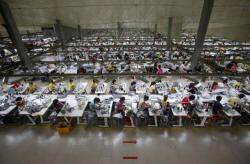Manufacturing vigor remains, strong currencies hinder
exports
 Send a link to a friend
Send a link to a friend
 [March 01, 2018]
By Jonathan Cable and Marius Zaharia [March 01, 2018]
By Jonathan Cable and Marius Zaharia
LONDON/HONG KONG (Reuters) - Manufacturing
data painted a mixed picture of economic activity across the globe, with
stronger currencies hurting exporters, but the growth momentum
demonstrated at the start of the year appears to have only dwindled
slightly.
The euro zone's boom has slowed a little further and Britain's factory
activity slipped to its lowest in eight months, yet China surprisingly
showed resilience amid fears tighter regulations may slow growth.
"Things came in a bit better than we expected. We are seeing pretty
strong global growth and demand," said Jacqui Douglas, chief European
macro strategist at TD Securities.
Factories across the euro zone are still enjoying their best growth
spell in almost two decades which, alongside price pressures at a near
seven-year high, will be welcomed by policymakers at the European
Central Bank as they move closer to unwinding their ultra-easy monetary
policy.

IHS Markit's final manufacturing Purchasing Managers' Index (PMI)for the
euro zone fell to 58.6 in February from 59.6, just pipping an earlier
flash estimate of 58.5 and comfortably above the 50 mark that separates
growth from contraction.
That robust growth came even though a sub-index measuring output prices
rose to 58.4 from 58.0, its highest reading since April 2011.
Despite a marked upturn in orders, Britain's factory PMI inched down to
55.2 in February, its second-lowest reading since June 2016's Brexit
vote though a shade above the average forecast of 55.0 in a Reuters
poll. [GB/PMIM]
Taken at face value, the figures suggest British factory output growth
so far this year has slowed to a three-monthly rate of 0.4 percent
compared with a robust 1.3 percent in the last three months of 2017, IHS
Markit said.
"Growth in the manufacturing sector is moderating, now that the recovery
in the euro zone has started to lose a little pace and more than 18
months have elapsed since sterling's huge depreciation," said Samuel
Tombs, chief UK economist at Pantheon Macroeconomics.
Surveys from the United States later on Thursday are expected to confirm
the strong momentum in global trade.
Federal Reserve chief Jerome Powell, in his first public appearance
since talking the helm at the U.S. central bank, said this week he aimed
to prevent the economy from overheating, cementing market expectations
for three or four interest rate increases this year.
Other central banks such as the Bank of England and Bank of Canada have
already raised interest rates and the ECB is widely expected to shut
down its money printing presses by the end of 2018.
However, chances for rate hikes in Asia are far lower.
Bank of Japan board member Goushi Kataoka warned on Thursday against a
premature exit from the BOJ's ultra-loose monetary policy and called for
a ramping up of the bank's massive stimulus program.

[to top of second column] |

Labourers work at a
garment factory in Bac Giang province, near Hanoi October 21, 2015.
REUTERS/Kham/File Photo

Also, the full impact of China's crackdown on risky financing probably
has yet to be seen.
A private survey showed factory growth at a six-month high, but the
findings were largely at odds with downbeat official activity readings
on Wednesday, which raised concerns that tighter regulations may lead to
a sharper slowdown in the world's second biggest economy.
State-owned firms service China's domestic demand more and their weaker
showing may point to weakness stemming from property-cooling measures,
higher interest rates and tougher rules against risky financing, factors
expected to weigh throughout the year.
Government measures to reduce pollution over the winter have also led to
cuts in production, economists said, while the Lunar New Year holidays
disrupted activity, suggesting the slowdown in some of the economies
could be temporary.
"These numbers imply that the low reading is likely driven by holiday
effects, rather than by any underlying slowdown in coming manufacturing
activity," said Iris Pang, Greater China economist at ING.
EXPORT HITS
Manufacturing was a relative bright spot for Britain's economy late last
year but growth in overseas orders slowed to its weakest in four months
in February.
Japanese manufacturing expanded at a slightly slower pace in February as
a stronger yen weighed on new export orders and Taiwan's factory growth
was the slowest in four months, although both economies still posted
relatively solid numbers.
South Korea's export growth slowed in February to its weakest in more
than a year.
The Japanese yen <JPY=> is currently trading around its strongest in
more than a year, the Korean won <KRW=> in more than three years and the
Taiwanese dollar <TWD=> in more than five.

"For Asia, the strength of the currencies will have some impact but
generally how growth in the G3 economies fares is more important," said
Khoon Goh, head of Asia research at ANZ.
"We should continue to see a strong momentum in exports going into the
second half, when base effects come into play," Goh said, cautioning
against reading to much into the holiday-distorted numbers.
(Editing by Catherine Evans)
[© 2018 Thomson Reuters. All rights
reserved.] Copyright 2018 Reuters. All rights reserved. This material may not be published,
broadcast, rewritten or redistributed.
Thompson Reuters is solely responsible for this content. |